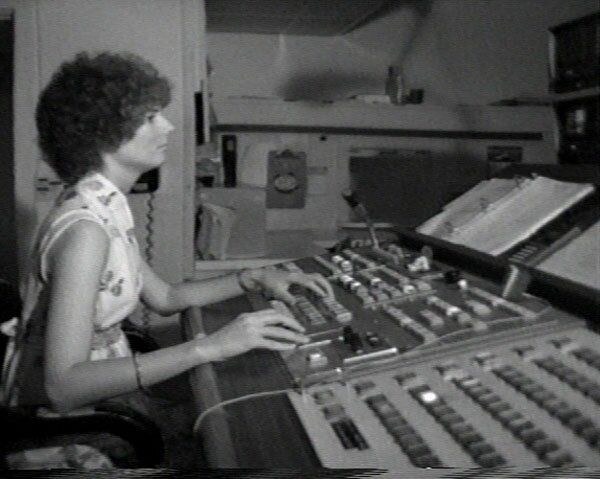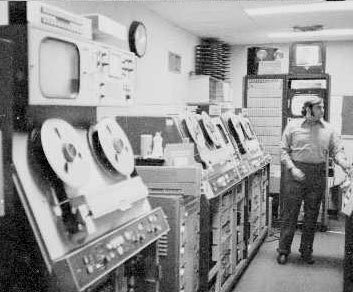|
Video Tape Recording |
Video tape recording was introduced by the Ampex Corporation in 1956, and it's reasonable to assume that 13 did not get the first allocation. A date for Channel 13's use of video tape recording is hard to pin down, but a newspaper article from the fall of 1956 states that the delivery of a first generation VTR would occur within months. Until then, the only method of recording studio programming was by kinescope, i.e.: Aiming a 16mm sound camera at a monitor. 13 preserved some early programming in this manner.
The classic Ampex VR-1000
RCA'S all-transistorized TR-22, introduced in the early 1960s
Ann Williams at the master control console (1977)
Computer aided station breaks were still a few years away. Ann calls for machines to roll while selecting the necessary 'take' button and fader on her switcher
Besides making reliable video tape recorders such as the VR-1000, VR-1100, VR-1200, and VR-2000, Ampex also produced an analog magnetic video disk recorder. The mobile unit held an Ampex HS-100, with a storage time of about 30 seconds. The studio used an HS-200 with about :30 of storage. The HS-200 worked with a simple computer that allowed for greater control of reverse, freeze, or slo mo playback of video signals. The disk was a big hit with sports productions, and was used often in studio sessions as well.
WTVT's tape room in the mid-70's. In the foreground is an Ampex VR-1200.
Engineer Rick Rea stand beside two Ampex VR-2000Bs. One of them was
equipped with the Ampex Editec that had animation capability.
Master control received a new shipment of quad VTRs in the early 70's. The AVR-1, Ampex's most advanced VTR, was delivered and immediately improved the station's on-air look. Stabile and engineering-friendly, the station's two AVR-1s provided quad service until the mid-1980s, when 1" type C VTRs were introduced.

Engineer Rick Rea with the ACR-25 control panel
Another innovation was the Ampex ACR-25, the first quad VTR that used a cassette-style cartridge. This machine was specifically designed for playback of commercials and spot announcements. It's unique vacuum design drew the tape out of the cartridge and wrapped it around the VTR's playback heads. The ACR-25 could hold 24 two-inch quad tapes in a carousel arrangement, and be programmed via computer for playback. By 1977, all commercials and spot announcements were played back by the station's two ACR-25s.

